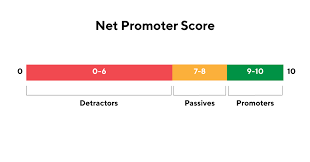When a friend or colleague takes the time to tell you about a product or service, you probably pay attention. Your friend is more reliable than a Yelp review, right? Word of mouth is the most common way people hear about brands. But how can you tell if your existing customers like your company enough to recommend it to their friends? One way is by tracking your Net Promoter Score (NPS).
Is NPS really the best way to measure customer loyalty? Some service leaders aren’t convinced. We wanted to explore the pros and cons of this popular (and sometimes controversial) metric by reviewing what it is, why it’s important, and why some Service Trailblazers choose to measure loyalty in other ways.
What is a Net Promoter Score?
The Net Promoter Score is a customer experience metric that captures how likely a customer is to recommend your products, services, or brand. Created by Fred Reichheld in 2003, NPS has since been widely adopted.
To find NPS, businesses ask customers: “On a scale from 0 to 10, how likely would you be to recommend our company to a friend or colleague?” Typically, companies follow up with an open-ended question to understand why a customer chose their score.
Customers are categorized as promoters, passives, or detractors based on their scores:
- Promoters (9 to 10): Loyal enthusiasts who will likely recommend your business to others and help attract new customers.
- Passives (7 to 8): Satisfied but not devoted customers who may switch to a competitor if presented with a better offer.
- Detractors (0 to 6): Unhappy customers who may negatively affect your business reputation and growth through bad word of mouth or reviews.
By understanding these categories, businesses can gain insights into customer loyalty and take action to improve customer experiences and foster stronger relationships.
How to Calculate Net Promoter Score
A company’s NPS is calculated by subtracting the percentage of detractors from the percentage of promoters. For instance, if you have responses from 100 customers, with 30 promoters and 18 detractors, your NPS would be 12.
Why is the Net Promoter Score Important?
Companies use NPS to gain insights into individual customer experiences and understand the overall perception of their products, services, and brand. NPS feedback helps address individual issues, enhance product offerings, and apply customer service principles effectively.
An improving NPS indicates positive changes that matter to customers, while a sudden drop signals potential issues that need attention.
What is a Good Net Promoter Score?
NPS can range from -100 to +100. While anything above 0 indicates more promoters than detractors, industry-specific benchmarks provide a more nuanced view. For example, the average NPS in the insurance industry is 74, whereas in healthcare, it’s only 45.
According to Bain & Company, the creators of NPS, a score above 0 is considered good. Scores over 20 are favorable, over 50 are excellent, and above 80 are world-class. Comparing your NPS to industry benchmarks helps gauge your customer experience relative to competitors, though it’s important to consider the context, such as company size and market scope.
What is a Bad Net Promoter Score?
Any NPS below zero is considered bad, as it means more customers are dissatisfied than satisfied. A significantly lower NPS compared to competitors may indicate the need to re-evaluate your customer service experience and address gaps that cause dissatisfaction.
What Can You Measure Using NPS?
NPS provides insights into:
- Customer Loyalty: Measures willingness to recommend.
- Enthusiasm: Differentiates between promoters, passives, and detractors.
- Overall Satisfaction: Gauges broad satisfaction with your business.
Bain & Company’s data shows that companies with long-term profitable growth have an NPS twice as high as the average company.
How to Run Surveys and Collect Feedback
Running an NPS survey involves asking a single question, collecting responses, and calculating your NPS. Surveys can be distributed via email, text, in-store, or online at checkout, using a survey builder or NPS app for automation.
When to Run NPS Surveys
The timing of NPS surveys varies:
- During checkout: Captures immediate customer sentiment.
- Quarterly: Monitors NPS over time.
- After service interactions: Tracks sentiment more granularly.
Staggering surveys over time can provide a more organic picture of customer satisfaction.
How to Collect NPS Feedback
Following up with an open-ended question like, “What’s the primary reason for your score?” helps gather actionable insights. This feedback can highlight areas for improvement and strengths to build on.
How to Improve Your Net Promoter Score
Improving NPS requires both individual and broad strategies:
- Analyze NPS Regularly: Monitor shifts in promoter, passive, and detractor percentages. Segment scores by customer groups for deeper insights.
- Include the Whole Company: Ensure all departments understand and contribute to improving NPS.
- Reach Out to Unhappy Customers: Engage detractors to address issues and prevent negative word of mouth.
- Reward and Learn from Promoters: Offer perks and gather feedback from loyal customers to understand your strengths.
- Don’t Ignore Passives: Address specific issues to turn passives into promoters.
- Follow the Referral Money: Track customer referrals to understand their financial impact.
Implementing Net Promoter Score
Invest in NPS survey software that integrates with your CRM platform. Automate survey distribution and workflows to manage responses efficiently. Designate responsibilities for customer follow-ups and NPS analysis.
Measuring Your NPS is Just the Beginning
Your NPS provides valuable insights into customer loyalty and satisfaction. However, the follow-through on these insights is crucial for engaging customers and delivering better experiences. Measuring your NPS is the first step towards enhancing your overall customer experience.
🔔🔔 Follow us on LinkedIn 🔔🔔













